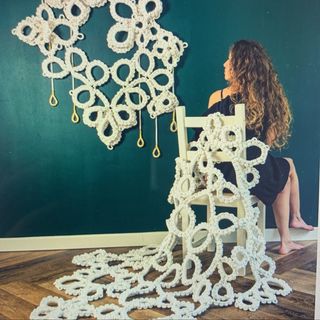If you thought of crochet.. guess again
I have always fancied any type of textile handcraft, and working with textiles I have done for as long as I remember. My patience to learn so many handcraft techniques has brought me to were I am today I guess.. And so my path to explore this even more during my time at the Rietveld Academie landed me towards my journey on the TXT department. Where techniques like knitting or crochet helped me build many projects, it was tatting that kept fascinating me. This extremely fine lace that is evenly gracious and strong, build up out of loops of knots. Made with this little tool shapes like an eye. Lace that can be produced by only one single thread and tool.
But it has been extremely difficult to let others see this technique for what it is. It is constantly mistaken to be crochet or knitting.
If you have landed here on my website I invite you to come and have a closer look in the world of frivolité, or also known as tatting. A technique that has wrapped me around the finger, a unique technique of knotting lace.
For over a decade i have devoted my skills and passion of handcraft textile in to this particular technique. I surely hope to convince the architectural landscape to become more frivolous again.
Lets use amazing ancient handcrafts again to construct and decorate.
Lace can be produced by various textile techniques, but tatting has also been around for a long time already. We used to give it function, as an antimacassar, protecting our furniture from greasy stains. We used it to fashion our collars or handkerchieves, or create doily’s functioning as coasters.
But times change and so has the use of tatting. As a maker I embraced this beautiful complex technique and focus on forcing it out of it’s comfort zone. Can this lace make a come back? Can I create new function and existence in today’s world.
In my effort to do so, I enlarge the technique while using fisherman’s rope, lines that nowadays are used in sailing, or climbing. Ropes that I recycle, that have already seen many seas, or ropes that were left overs from the industry, as in unpopular colours. Nowadays ropes are being produced from recycled plastic bottles, making it easier to make sustainable material choices.
Using rope doesn’t only allow me to magnify the structure of the technique, it also enables the lace to take on a more serious role other then decorative purposes. It provides me the volume I like to build in so it can be functional in different disciplines. And rope is the perfect material to be used for interior and exterior designs.
Follow my process where I work the lace into 3d structures proving that even lace can be used to construct firm designs while honouring it’s traditional handcraft fabrication.
